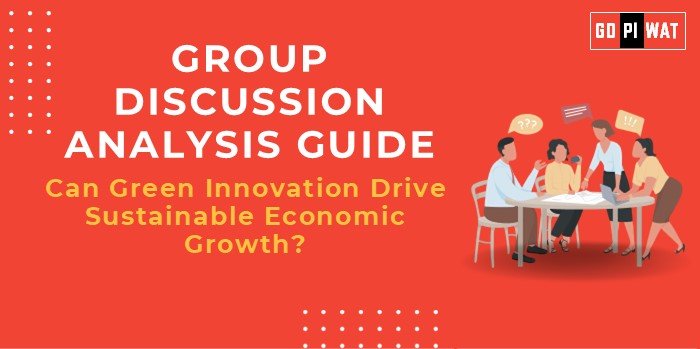📋 Group Discussion (GD) Analysis Guide
💡 Topic: Can Green Innovation Drive Sustainable Economic Growth?
🌐 Introduction to Green Innovation
Opening Context: In a world grappling with the twin crises of climate change and economic inequality, green innovation stands as a potential solution that aligns environmental sustainability with economic progress.
Topic Background: Green innovation refers to technological and process advancements designed to reduce environmental impact. Originating in the 20th century’s sustainability movements, it has gained traction with global efforts like the Paris Agreement, promoting eco-friendly solutions. Recent trends in renewable energy, circular economy practices, and green financing underscore its relevance.
📊 Quick Facts and Key Statistics
- Global Investment in Clean Energy (2023): $1.7 trillion — Outpaces fossil fuel investments for the first time.
- Job Creation in Renewable Energy: 12.7 million jobs worldwide in 2022, led by solar and wind sectors.
- Carbon Reduction Potential: Adoption of green innovations can cut global CO₂ emissions by 40% by 2030 (IEA).
- Market Growth: Green technology market expected to grow at a CAGR of 21.9% from 2023 to 2030.
🔗 Stakeholders and Their Roles
- Governments: Policy-making, subsidies, and international agreements like the Paris Accord.
- Private Sector: R&D, green startups, and corporate ESG initiatives.
- Academia and Research Institutions: Driving technological breakthroughs.
- Citizens and Activists: Demand-side pressure for sustainable products.
- International Organizations: Advocacy and funding, e.g., UN SDGs.
🏆 Achievements and Challenges
Achievements:
- Economic Growth: The EU’s Green Deal projects net GDP growth of 0.5% annually through 2050.
- Renewable Milestones: India’s solar capacity increased by 80% in the last decade.
- Technological Advancements: Innovations in energy storage and carbon capture.
- Circular Economy: Denmark recycles 69% of its waste.
Challenges:
- High Costs: Green technology deployment requires significant upfront investment.
- Policy Gaps: Uneven global adoption due to regulatory inconsistencies.
- Resistance: Industries reliant on fossil fuels face transition challenges.
- Global Comparison: While Norway leads in EV adoption, developing nations face infrastructure deficits.
📚 Structured Arguments for Discussion
- Supporting Stance: “Green innovation is the cornerstone for decoupling economic growth from environmental degradation.”
- Opposing Stance: “The economic feasibility of green innovation is questionable, especially for developing economies.”
- Balanced Perspective: “Green innovation drives long-term growth but needs global cooperation and equitable funding mechanisms.”
✨ Effective Discussion Approaches
- Opening Approaches:
- Data-driven: “Green investments in 2023 surpassed fossil fuels for the first time globally.”
- Policy angle: “The Paris Agreement mandates urgent innovation for economic and environmental resilience.”
- Counter-Argument Handling:
- “High costs are a valid concern; however, subsidies and green financing options can mitigate initial expenses.”
🔍 Strategic Analysis (SWOT)
- Strengths: Sustainability, global market opportunities, job creation.
- Weaknesses: High initial costs, technological gaps.
- Opportunities: Green financing, international collaborations.
- Threats: Policy inertia, resistance from traditional industries.
🌟 Connecting with B-School Applications
- Real-World Applications: Business models focusing on ESG metrics, renewable energy projects, and sustainable supply chains.
- Sample Questions:
- “How can green innovation balance profitability and sustainability?”
- “Discuss examples of successful green innovations globally.”
- Insights for Students: Explore career opportunities in green finance, sustainable consulting, and renewable technologies.


